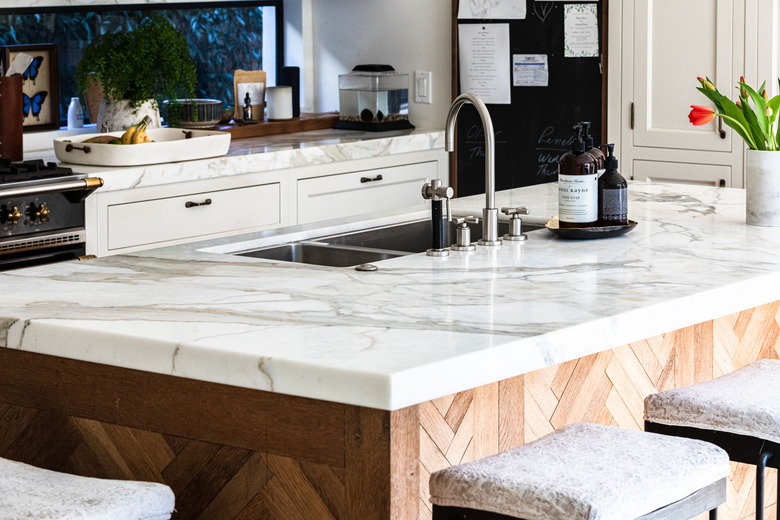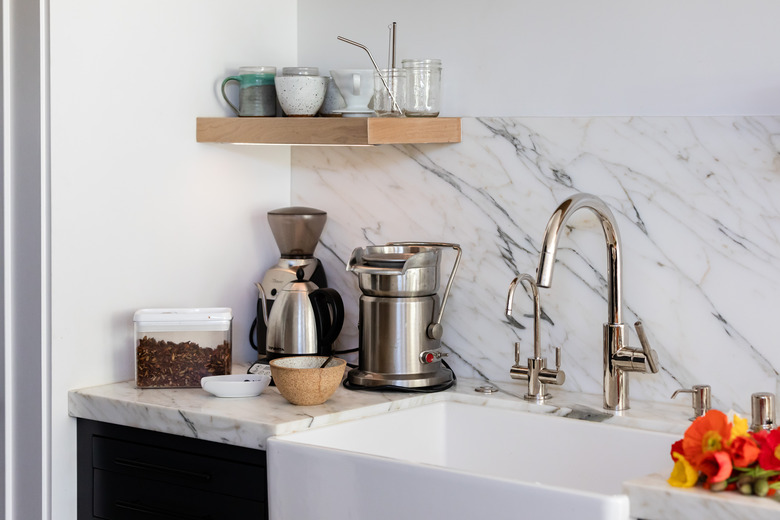What Are High-Arc Kitchen Faucets?
We may receive a commission on purchases made from links.
When it comes to choosing the ideal kitchen faucet, one factor that's often overlooked is the faucet's height. A high-arc faucet stands high above the sink, while a low-arc faucet's compact profile isn't as easily noticed from across the room. A deep sink and a high-arc faucet pair well together, providing ample space to wash vegetables or fill deep pots.
While a swiveling high-arc faucet is an excellent choice for a sink with more than one bowl or compartment, a tall faucet isn't ideal in every situation. The size and depth of the sink as well as the view and available space behind the sink are all worth considering before choosing a faucet with a high arc.
Tip
A high-arc faucet is a faucet that stands at least 8 inches tall from its base to its highest point.
What is a High-Arc Faucet?
What is a High-Arc Faucet?
A high-arc faucet, sometimes called a gooseneck faucet, stands taller than low-profile or low-arc faucets. While there's not a set size guideline for "high" arc designation, this type of faucet usually stands 8 to 10 inches from the top of the counter to the highest point of the faucet, according to Moen. Any faucet taller than 10 inches and that curves or hooks near the top is also a high-arc faucet. By comparison, a low-arc faucet sits 3 to 8 inches above the top of the counter. Some companies designate the mid-range size (5 to 8 inches tall) as mid-arc faucets, although this isn't a common practice.
The high-arc designation only applies to faucets that mount to the actual sink or countertop, not wall-mounted faucets. High-arc faucets may be fixed in place or may swivel so the spray can reach more than one sink bowl. If the faucet doesn't swivel, it may have a pull-down or pull-out spray nozzle instead. These options could be crucial to selecting the faucet that best suits your needs in the kitchen. In many cases, a high-arc faucet is a better choice than a low-arc variety in the kitchen, as the height offers ample room to fill stock pots or to swivel the faucet from one sink bowl to the next.
When trying to decide between several high-arc faucets, inspect them or read product literature carefully to determine the height from the tip of the spout or aerator to the top of the sink plane, as this helps determine whether tall pots can easily be filled and maneuvered beneath the spout. A tall high-arc faucet doesn't necessarily mean a vast amount of space between the aerator and the top of the sink. Two different models of 10-inch-tall high-arc faucets may vary by a couple of inches when it comes to the space from the tip of the aerator down to the level of the sink's top.
Faucet Spout Reach
Faucet Spout Reach
The spout's reach is another important factor to consider, especially for a swiveling high-arc faucet. The reach is the horizontal distance from the center of the faucet base at countertop level to the center of the water stream as it reaches the sink, according to Kohler. Visualize a pencil-thin stream of water coming out of the spout and then measure that distance in a horizontal line to the center of the faucet base to determine spout reach. The spout reach is important because it determines where the water will fall in the sink.
If a spout only reaches a couple inches from the back of the sink, it could be difficult to fill a large pot that sits in the sink. It could also be hard to run water in every bowl of a three-bowl sink. Even washing hands could prove cumbersome for some people due to having to stretch and bend over the sink to reach the water.
The mounting location of the faucet also determines where the water will fall into the sink. For instance, there may be an inch or so of space between the center of the faucet base and the back edge of the sink if the faucet is mounted to the countertop behind the sink.
It's good for the spout reach to fall somewhere near the center of the sink bowl or even a little closer to the front of the sink, whether dealing with a single-bowl sink or a multi-bowl version. If the water doesn't reach quite that far, it could be difficult to rinse the sink thoroughly if the faucet doesn't have a sprayer.
High-Arc Faucet Pros and Cons
High-Arc Faucet Pros and Cons
Pros
- Functional and convenient
- Come in a variety of styles and finishes
- Allows for lots of sink space
Cons
- Not ideal for small spaces
- May block the view from a kitchen window
- Unwanted water splashes are likely
Convenience and functionality are two of the main reasons to choose a high-arc faucet for a kitchen, but they also contribute to the overall look of the kitchen in that they're quite obvious compared to low-arc faucets. For this reason, a vast array of styles and finishes are available, allowing you to pick a faucet that pairs well with the existing metal finishes present in the kitchen.
Without considering sprayers as an option, a high-arc faucet offers plenty of room to use the water regardless of what's already in the sink. For instance, if you already have a pot soaking in the sink but want to add some water to a saucepan, there's usually room to slide and hold the saucepan under the spout without moving the pot in the sink. With a low-arc faucet, this could prove difficult or even impossible.
Although a high-arc faucet is helpful when filling large pots, it's not always the best option for every kitchen. For instance, if the bottom of a kitchen window starts just above sink level, a high-arc faucet could disrupt the view. If that window opens inward or even if you want to remove the screen to wash it, a tall faucet could be in the way. In this case, a low-arc faucet is a good choice.
High-arc faucets may also contribute to more splashing than low-arc faucets, especially if the sink is shallow. For instance, running even a thin stream of water onto dishes stacked in a shallow sink could result in splashes that leave the sink or even splatter your shirt. Splashing could also be an issue when washing your hands too close to the spout of a high-arc faucet, resulting in a wet mess. Holding your hands lower in the sink bowl helps prevent such splashes no matter how tall the faucet.
Installation Requirements for High-Arc Faucets
Installation Requirements for High-Arc Faucets
As with other types of faucets, some high-arc varieties have different mounting or installation requirements than others. Check your kitchen sink for faucet-mounting holes. If it has three, for instance, look for a faucet that requires three or fewer holes. If your sink has no faucet-mounting holes, that means any configuration of high-arc faucet is possible for your kitchen since the faucet mounts to the countertop behind the sink.
If your sink has faucet-mounting holes, the distance between the holes also matters. For example, a sink that has three mounting holes with the outer holes set 8 inches apart center to center is designed for a faucet that also measures 8 inches center to center from one handle to the other. In some cases, deck plates are available to cover unneeded holes if you choose a different type of faucet that requires fewer holes, such as a single-handled variety. It's generally best to choose the faucet configuration designed for your sink setup because then you won't have to deal with extra holes.
If your countertop has holes in it from a faucet you're replacing, it's best to stick with the same hole configuration when choosing the new faucet, for much the same reason.
Hands-Free High-Arc Faucets
Hands-Free High-Arc Faucets
For a little something extra in a high-arc faucet, touchless or touch-activated features help save water while keeping the faucet fixtures clean. Both touch and touchless features are geared toward high-arc faucets in that the faucet height offers plenty of room for hand washing beneath the spout. While the touchless variety senses motion and turns the water on with no touch at all, the touch-activated type turns on when your wrist, arm or elbow touches a designated part of the faucet, such as the curved arc near the top of the faucet.
Such features mean no more dirty hands mucking up the faucet's handles or knobs. Read the product features before choosing a specific model; many such faucets allow you to set the water temperature ahead of time so the water is a comfortable temperature when you activate the faucet's sensors. Some high-end models even emit colored lights that change with the water's temperature so you won't have to guess when the water reaches the specified temperature range.
One important factor to consider with both touchless and touch-activated faucets is that they require a source of electricity. Some models are battery powered, while others plug into an outlet. If you are using the plug-in variety, the touchless or touch-free feature won't work during a power outage, but this is not the case with battery-powered models. Some companies allow the option for either battery or plug-in power, although the power adapter may be sold separately.
Sprayers for High-Arc Faucets
Sprayers for High-Arc Faucets
A sprayer is an excellent option for any kitchen sink and any faucet type, allowing you to rinse food debris off pots or rinse out the sink after draining the dishwater. A pull-down sprayer pulls straight down from the spout area and is ideal for tasks such as filling or rinsing large pots. The sprayer assembly is virtually invisible when not in use, as it retracts back into the faucet.
A pull-out sprayer, which is similar but is generally found on low-arc faucets, offers comparable convenience but doesn't look quite as nice, largely because a large portion of the faucet becomes the "handle" for the sprayer. In most cases, these are not found on high-arc faucets, largely because the angle of a high-arc faucet points the spout down, resulting in a pull-down type of sprayer assembly.
The side sprayer offers yet another option. This one doesn't mount inside the faucet tube but stands on its own off to the left or right. This is the classic handle-and-trigger type of sprayer found in kitchens with just about any type of faucet. In many cases, a side sprayer is included with the purchase of a faucet and matches it, but some companies also sell them individually.
If the sprayer or hose fails, these can be replaced at less expense than buying an entire new faucet. Companies that sell spare sprayer assemblies make them in finishes to match specific faucet models, although some also sell universal sprayers that are compatible with many faucets.

